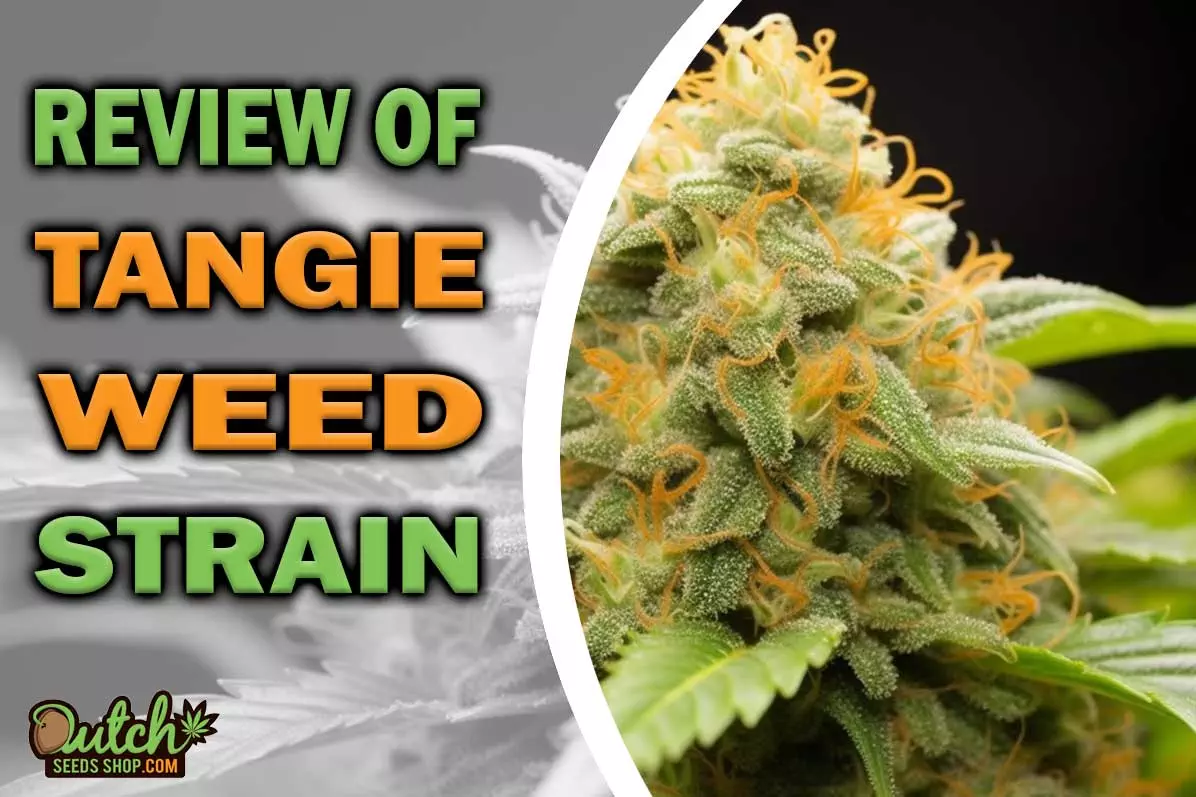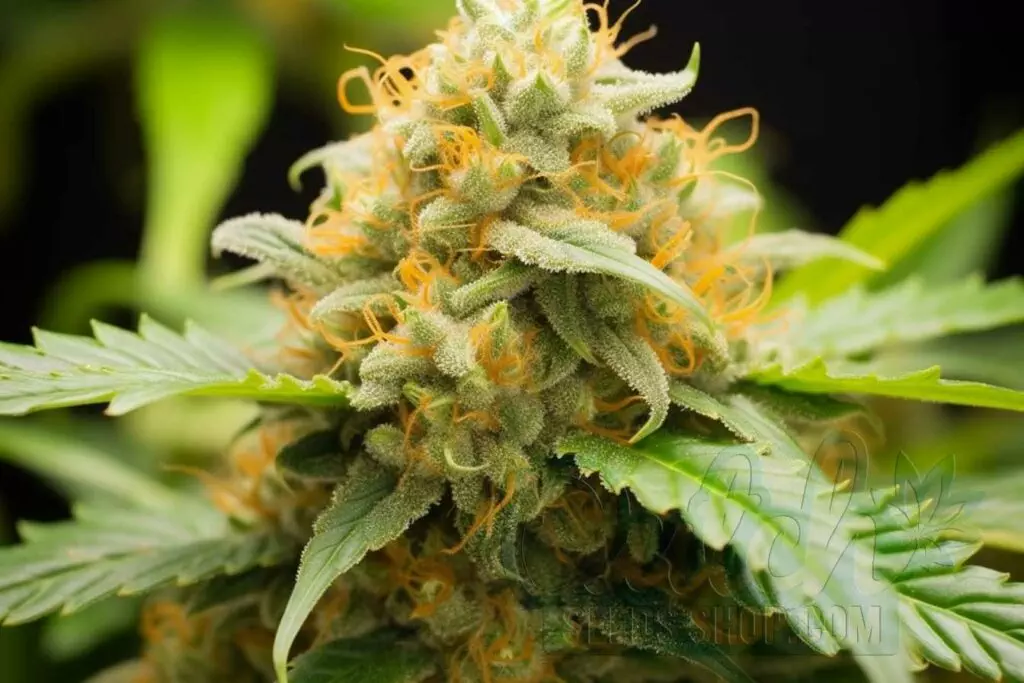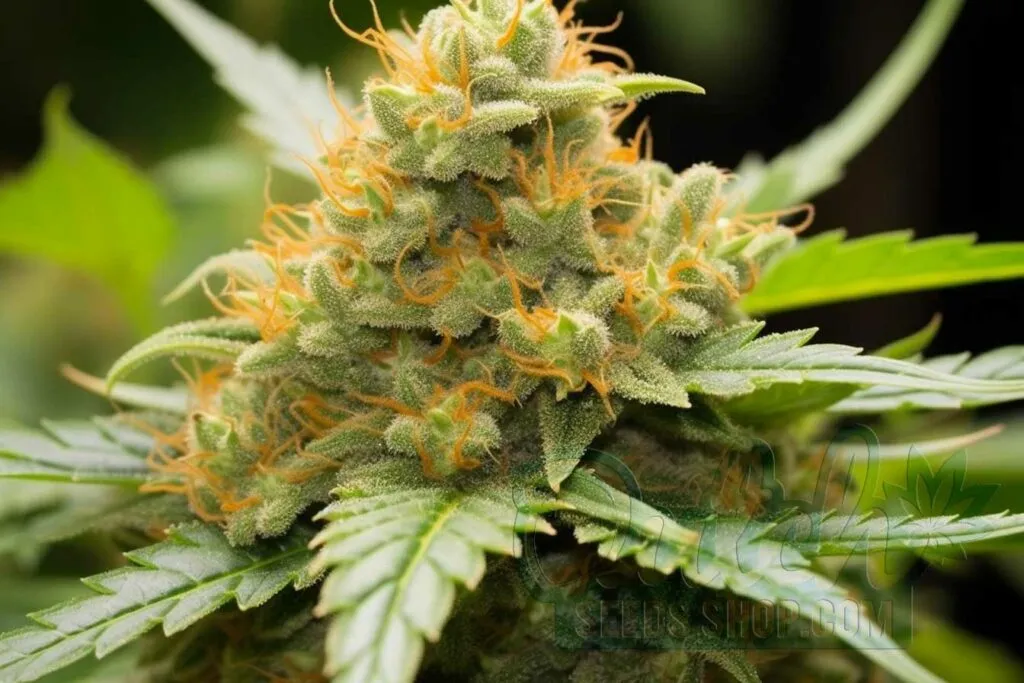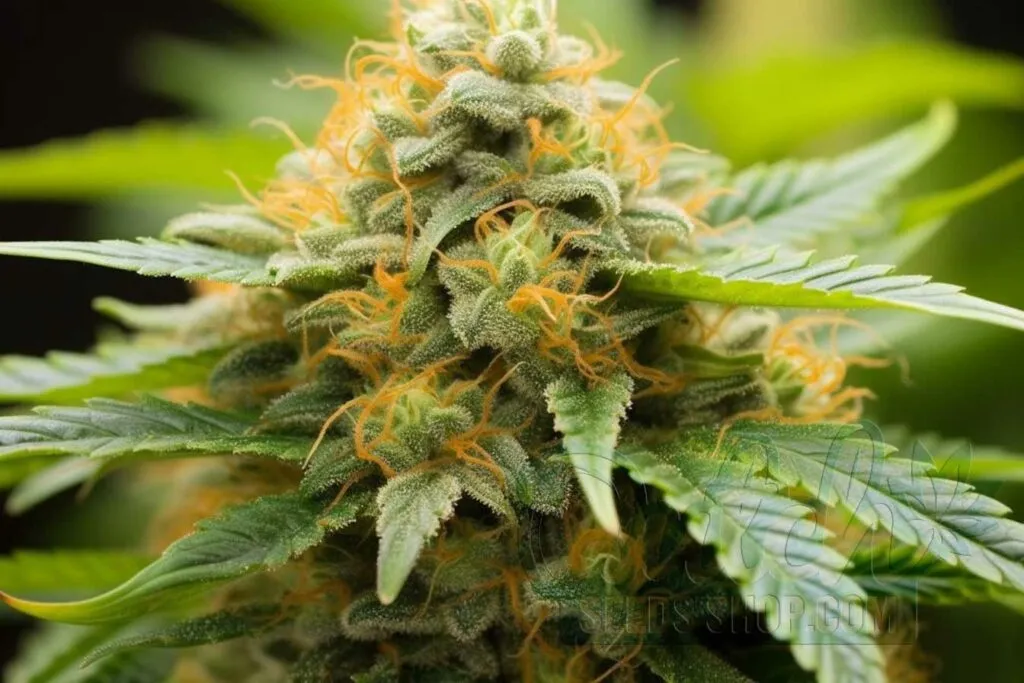Tangie Marijuana Strain Information and Review
Embarking on a journey through the vibrant world of the Tangie marijuana strain, we uncover a treasure trove of sensory delights and cultivation wonders. This strain, known for its tantalizing aroma and invigorating effects, has captivated cannabis enthusiasts and cultivators alike.

Type: 30% Indica / 70% Sativa
Genetic: California Orange x Skunk
THC: 13 – 22%
CBD: 0.01 – 1%
Terpenes: Carene, Caryophyllene, Myrcene, Phellandrene
Flowering Time: 63 – 70 days
Indoor Yield: 1.5 – 2 oz/ft²
Outdoor Yield: 17 – 25 oz/plant
Effects: Analgesic, Calming, Happy, Sleepy
Flavors/Taste: Earthy, Floral, Lemon, Sour
Tangie’s distinct profile, marked by its citrusy flavor, energizing high, and growing ease, places it amongst the most cherished strains in the cannabis community.
Its ability to inspire creativity and happiness makes it a go-to choice for those seeking a euphoric experience.
Key Takeaways:
- Tangie, a sativa-dominant strain, is known for its uplifting and creative effects, making it popular among cannabis enthusiasts.
- A cross between California Orange and Skunk, Tangie inherits sweet citrus flavors and robust growth characteristics.
- Its visually striking appearance features vivid green and orange hues, dense buds, and abundant trichomes.
- The terpene profile of Tangie, rich in myrcene and limonene, contributes to its distinctive mandarine and fruity aroma.
- With THC levels ranging from 12% to 22% and low CBD content, Tangie offers a potent yet balanced experience.
- Tangie is effective in alleviating stress, depression, and fatigue, offering significant medical benefits.
- It can be grown both indoors and outdoors, preferring a mild climate, with a flowering time of 63 to 70 days.
- Tangie seeds are available in regular, feminized, and autoflowering varieties, catering to different cultivation preferences.
- Appropriate feeding and nutrient management are crucial for optimizing Tangie’s growth and maximizing yield.
Tangie Strain Genetics
Tangie’s genetics are a testament to the art of cannabis breeding, showcasing a perfect blend of taste, aroma, and effects.
Its genetic makeup, a harmonious blend of sativa and indica traits, offers a unique experience to both growers and users.
This strain’s lineage, deeply rooted in the history of cannabis cultivation, highlights the ingenious efforts of breeders who have shaped its evolution.
Origins and Lineage
The origins of the Tangie strain are as intriguing as its effects.
A cross between the flavorful California Orange and the iconic Skunk, Tangie inherits the best traits from both parents.
The California Orange contributes its sweet, citrusy flavors, while the Skunk strain lineage adds a layer of complexity to the aroma and ensures robust growth characteristics.
This genetic combination results in a strain that is not only enjoyable to consume but also a pleasure to cultivate, especially for those venturing into the world of cannabis growing.
History
Tangie’s history is a colorful narrative, tracing back to the 1990s when the cannabis culture was undergoing significant transformation.
Over the years, Tangie has evolved, adapting to the changing preferences of users and growers.
It has emerged as a favorite in dispensaries and cannabis cafes, praised for its unique flavor profile and consistent, high-quality effects.
The journey of Tangie, from its early days to becoming a modern classic, is a reflection of the dynamic nature of cannabis breeding and the continuous quest for perfection.
Appearance of Tangie Weed
The appearance of Tangie weed is nothing short of stunning.
Its buds are a beautiful blend of green and orange hues, covered in a sparkling layer of trichomes that hint at its potency.
The bud structure is dense yet fluffy, a characteristic inherited from its Skunk ancestry.
This visual appeal is complemented by its distinct aroma, making it an alluring choice for cannabis connoisseurs.
- Color: Vivid green with hints of orange
- Bud Structure: Dense and fluffy
- Trichomes: Abundant and crystal-like
- Visual Characteristics: A sparkling layer of trichomes, vibrant coloration
Is Tangie Indica or Sativa?

Tangie is predominantly a sativa strain, with about 70% sativa and 30% indica genetics.
This sativa dominance is evident in its growth characteristics and the effects it produces.
The strain grows to a medium height, typical of sativa varieties, and offers a cerebral, uplifting high that stimulates creativity and euphoria.
The indica component, though less pronounced, contributes to the overall balance of effects, providing a subtle relaxation that complements the energetic sativa buzz.
Cannabinoids and Terpenes
The allure of the Tangie strain lies not just in its striking appearance and lineage but also in its intricate cannabinoid and terpene composition.
This profile is responsible for the strain’s unique therapeutic properties and its distinctive sensory experience.
Understanding these components is crucial for both users seeking specific effects and cultivators aiming to optimize these traits in their harvest.
Terpenes Profile
The terpene profile of Tangie plays a pivotal role in defining its exceptional aroma and flavor.
Terpenes, the aromatic compounds found in cannabis, contribute significantly to the strain’s overall experience.
- Myrcene: Imparts earthy and musky notes, enhancing the strain’s natural sweetness.
- Limonene: Responsible for the citrusy, tangy aroma, evoking the scent of fresh mandarins.
- Caryophyllene: Adds a hint of spiciness, complementing the fruity undertones of Tangie.
- Pinene: Brings a refreshing pine aroma, contributing to the strain’s invigorating scent profile.
THC and CBD levels
Tangie’s cannabinoid content is a key factor in its effects and medical benefits.
The strain typically exhibits a range of THC levels from 12% to 22%, while the CBD content remains below 1%.
This high THC to low CBD ratio is indicative of Tangie’s potency and its ability to produce a strong, cerebral high.
| Cannabinoid | Level |
| THC | 12% – 22% |
| CBD | <1% |
Aroma and Flavor
Tangie’s aroma and flavor are as distinctive as its appearance.
The first whiff of this strain releases a burst of citrus and sweet notes, reminiscent of mandarines and ripe fruits.
This is followed by subtler undertones of sweetness, adding depth and complexity to the strain’s profile.
The flavor mirrors this aromatic bouquet, delivering a delightful and lingering aftertaste that encourages repeated enjoyment.
Tangie Strain Effects and Medical Benefits
The effects and medical benefits of Tangie are as diverse as its genetic makeup.
This strain is not only a source of recreational pleasure but also a valuable ally in addressing various medical conditions.
Its balanced cannabinoid and terpene profile make it suitable for a wide range of users, offering both psychological upliftment and physical relief.
Feelings

Upon consumption, Tangie induces a range of feelings, predominantly characterized by a euphoric and energetic high.
Users often report a sense of heightened creativity and happiness, making it an excellent choice for social gatherings or creative endeavors.
Its sativa dominance ensures a cerebral experience, elevating mood and invigorating the mind.
Negatives
While Tangie is generally well-received, it’s important to be aware of potential negatives.
Common side effects include dry mouth and dry eyes, which are typical with high-THC strains.
Moderation and hydration can help mitigate these effects, ensuring a pleasant experience.
Tangie Strain Helps With
Medically, Tangie has been known to offer relief from a range of conditions.
Its uplifting effects can help alleviate symptoms of stress and depression, while its energizing nature makes it effective against fatigue.
For medical patients, Tangie serves as a source of comfort, improving their quality of life through its therapeutic properties.
Growing Tangie
Growing Tangie is a journey filled with rewards and learning opportunities.
This strain, known for its easy grow difficulty, is well-suited for both novice and experienced cultivators.
Its adaptability to various growing conditions and its impressive yield potential make it a favored choice in the cannabis cultivation community.
Tangie Seeds
When selecting Tangie seeds, growers have the option to choose between regular, feminized, and autoflowering varieties.
Regular seeds produce both male and female plants, ideal for breeders.
Feminized seeds guarantee female plants, ensuring a more straightforward cultivation process focused on bud production.
Autoflowering Tangie seeds are a great choice for those seeking a faster and more manageable growth cycle, as they flower independently of the light cycle.
Growing Guide
Growing Tangie requires an understanding of its specific needs to maximize its potential.
The strain’s sativa dominance suggests a preference for certain environmental conditions and care techniques.
By adhering to a well-thought-out growing guide, cultivators can ensure the healthy development of their Tangie plants.
Indoor and Outdoor Growing Info
Indoor cultivation of Tangie allows for greater control over environmental factors such as temperature, humidity, and light cycles.
In an indoor setup, growers can manipulate these conditions to mimic the strain’s preferred climate, leading to optimal growth.
Outdoor growing, on the other hand, relies on natural conditions.
Tangie thrives in a mild climate with ample sunlight, making it well-suited for outdoor cultivation in suitable geographic locations.
The choice between indoor and outdoor cultivation depends largely on the grower’s environment and resources.
Feeding Tangie Plants
Feeding Tangie plants appropriately is crucial for their development.
This strain benefits from a balanced diet rich in essential nutrients like nitrogen, phosphorus, and potassium.
During the vegetative stage, a higher nitrogen intake supports leaf and stem growth, while during the flowering stage, increased phosphorus and potassium levels promote robust bud development.
Regular monitoring and adjustment of nutrient levels are essential to prevent issues such as nutrient burn or deficiency.
Flowering Time and Yield of Tangie Seeds

Tangie’s flowering time is typically between 63 to 70 days.
The yield varies depending on the growing conditions but generally ranges from 1.6 to 2 oz/ft² indoors and 17 to 25 oz per plant outdoors.
These figures highlight Tangie’s potential as a high-yielding strain, making it an attractive option for both personal and commercial cultivation.
Comparison of Alternative Strains to Tangie Strain
When comparing Tangie to similar strains like Sour Tangie and Purple Tangie, it’s essential to consider factors like flavor profile, effects, and cultivation requirements.
Each strain offers a unique experience, and understanding these differences can help users and growers make informed choices.
| Strain | Flavor | Effects | Yield (Indoor/Outdoor) | Flowering Time |
| Tangie | Citrus, Sweet | Euphoric, Energetic | 1.6 – 2 oz/ft² / 17 – 25 oz/plant | 63 – 70 days |
| Sour Tangie | Sour, Citrus | Uplifting, Creative | Similar to Tangie | Similar to Tangie |
| Purple Tangie | Berry, Citrus | Relaxing, Happy | Slightly lower than Tangie | Similar to Tangie |
1. Sour Tangie, as the name suggests, offers a sour twist to the classic citrus flavor of Tangie. Its effects are more focused on uplifting and creative aspects, making it a great choice for artistic activities or brainstorming sessions. The yield and flowering time are similar to Tangie, making it a convenient alternative for growers used to Tangie’s cultivation requirements. Sour Tangie is ideal for those who enjoy the energetic high of Tangie but prefer a tangier flavor profile.
2. Purple Tangie differentiates itself with a berry-infused citrus flavor, adding a sweet and fruity dimension to the Tangie experience. Its effects are more inclined towards relaxation and happiness, providing a more laid-back and cheerful experience compared to Tangie’s predominantly euphoric and energetic high. The yield is slightly lower than Tangie, but the similar flowering time makes it a manageable choice for growers. Purple Tangie is perfect for users who love the citrus aspect of Tangie but are seeking a more calming and joyous effect.
FAQ
What is the ideal climate for growing Tangie?
Tangie prefers a mild climate with ample sunlight.
Can Tangie be grown both indoors and outdoors?
Yes, Tangie adapts well to both indoor and outdoor cultivation environments.
What are the effects of consuming Tangie?
Tangie typically induces feelings of euphoria, creativity, and energy.
About the Author
